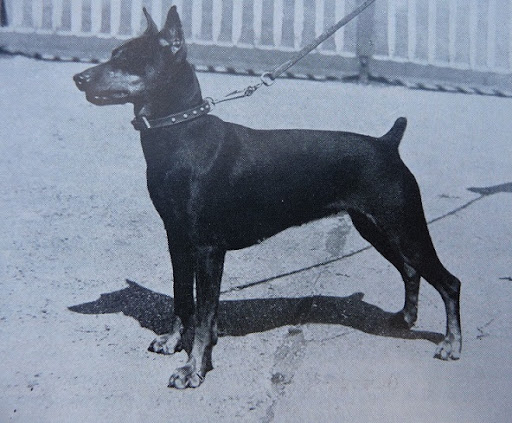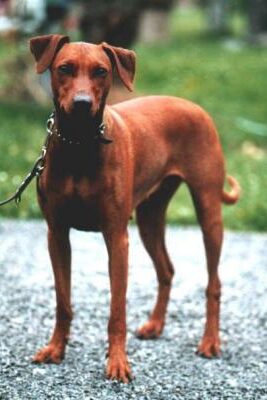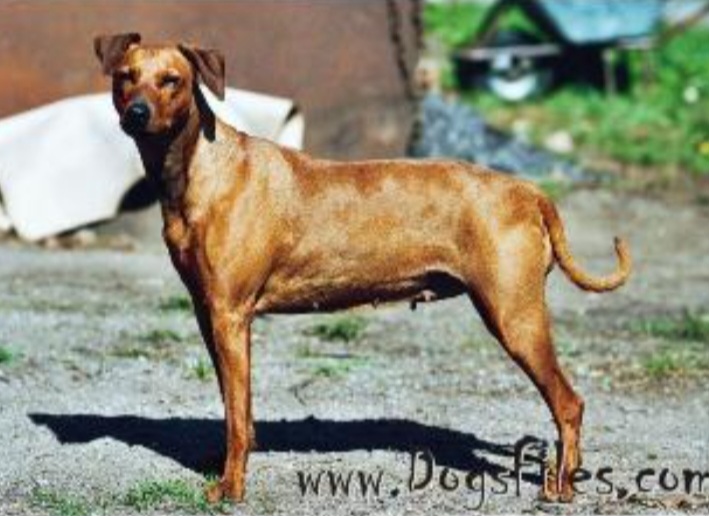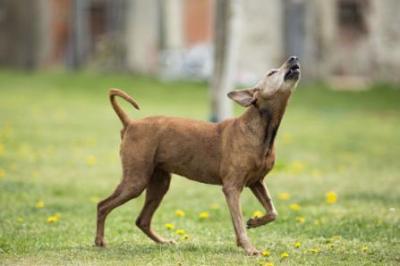The German Pinscher breed history
The smooth-haired pinscher is an ancient breed, mentioned by the German Breeding Club in 1880.

Modern representatives of the breed share the ancestors with schnauzers – they were called wirehaired pinschers. Initially, the smooth-haired pinscher differed from the wire-haired one in color and shorter coat. The coat of most dogs was black with light markings, but there was also a solid brown, sometimes even red. Some pinschers ranged in color from black to blue-gray, or «pepper and salt».
First pinscher mentions
It’s believed that German pinschers descended from ancient swamp dogs that lived in Europe and hunted rats and other small rodents. It’s hard to say whether that is true, since there is no evidence of such a relation between the pinschers and the swamp dogs.
First mentions of pinschers as an established group of dogs date back to the beginning of the 17th century, exclusively in the southwest of Germany. The main task of pinschers was to protect food supplies from rodents, their population in those days being very large and causing considerable damage. Hunting passion and distinct watchdog qualities of the pinscher were appreciated not only by villagers, but also by city residents. Therefore, very soon pinschers were kept as pets everywhere.

In addition to hunting and guard qualities, pinschers are also hardy and can accompany their owners on long journeys. Due to this, the breed had become even more popular. All self-respecting citizens rode in carriages along with a pack of pinschers, who made sure that onlookers did not fall under the wheels of the transport, and guarded the owner’s property when they were absent.

Until the second half of the 18th century there were two lines of dogs in the breed: smooth-haired and wire-haired pinschers (future schnauzers), however they were not separated. In the same litter could be puppies with different coat types, and even at shows they competed together. Each line had its admirers. Karl Dobermann was so delighted with the smooth-haired pinschers that he put a lot of effort in breeding a larger version. Thanks to him, the Pinscher became the main “producer” of the Doberman breed, famous for its detective talents.
Formation of the German Pinscher breed
Over time, pinschers began to be separated by coat. Only individuals of the same type of coat were breeded.

In 1880, the German Breeding Club for the first time proposed a separate standard for the Pinscher and Schnauzer. The two breeds were officially divided in 1884.
Initially, pinschers could be of any colour; restrictions appeared a bit later. The first standards for schnauzers and pinschers were almost the same, only the description of the type of coat differed. In 1895, the standard was revised to establish acceptable colours for Pinschers.

With the invention of cars, the popularity of pinschers began to decline. The First World War (1914-1918) had a negative effect on the breed. In 1923, the Pinscher-Schnauzer Club created the first stud book, registering 185 pinschers.
Only 2 dogs were born before the war. They had a significant influence on the breed. A black-and-tan male, Max von Goppingen, born in 1910, and a black-and-tan female, Bella von der Staufenburg, born in 1909. All more or less successful dogs were their descendants. In addition to these pinschers, two more males were mentioned in the stud book: Mehelen Max (date of birth unknown) and Flock, born in 1921.
In 1923, the breed standard was revised. The Pinscher was described as a luxurious but strong and muscular dog, 43-48 cm high. Acceptable colors were black- and brown-and-tan and solid red in varying degrees of intensity. White spots were not allowed. An exception was made only for the «pepper and salt» color due to the presence of Schnauzers in the pedigrees. In those years the German Pinscher breeders put a lot of effort into purebred breeding and produced some magnificent dogs. Unfortunately, at that time, the very famous breeder Strebel continued to stubbornly breed «pepper and salt» and «black and silver» pinschers. Daubner from Kaiserslautern followed the same dream. However, they were not successful. If the energies and efforts of these outstanding, «passionate, idealistic breed» breeders had been directed towards the breeding of black-and-tan and red Pinschers, the progress of the breed would have been enormous.
No major developments in the breed were made, until a Bartenbach breeder Retter made a big achievement. All the judges of that time spoke about the high quality of his dogs. 16 pinschers of his breeding became National Show Champions in Stuttgart. Among the winners were the black-and-tan male Arco von Barbarossa, the black-and-tan female Dorle von Barbarossa and the red male Arno von Barbarossa. However, World War II was approaching.
В послевоенный период пинчер потерял свою популярность, и разведение породы практически было сведено к нулю. Если в период с 1923 по 1949 год было зарегистрировано приблизительно 900 немецких пинчеров в Германии, то с 1950 по 1957 год не было зарегистрировано ни одного помета!
Post war the Pinscher lost its popularity, and its breeding was practically reduced to zero. While approximately 900 German Pinschers were registered in Germany between 1923 and 1949, not a single litter was registered between 1950 and 1957.
In the mid-1950s, president of the Pinscher-Schnauzer Club and a well-known Giant Schnauzer breeder Werner Jung made a speech trying to bring attention to the German Pinscher breed. Unfortunately, he was not heard. No one had any interest in pinschers. It could have been the end of the breed… However, Werner Jung would not allow the extinction of an entire breed, so he decided to try to restore it himself. His efforts were not in vain, and now, thanks to his dedicated work, we can enjoy these magnificent dogs.
In 1958, five Pinschers were registered in the Pinscher-Schnauzer Club studbook. They had a fundamental influence on the revival of the breed.
Revival of the German Pinscher breed
Black-and-tan female Kitti vom Bodestrand (45 cm in height), the breeder – Kirchmeier from Stassfurt. She was born in 1955 from dogs of an old breed.

Black-and-tan female Jutta v. Weinberg (40 cm in height), the breeder – Jung. Born in 1956.


Three other registered pinschers were overgrown male miniature-pinschers.
Red Fürst v. Weinber (42 cm in height), the breeder – Jung.

Black-and-tan Illo (Fischer) (37 cm in height), the breeder – Fischer.
Brown-and-tan Onzo vom Thekenhaus (42 cm in height), the breeder – Illgen. Born in 1957.
All of these dogs were carefully selected by Werner Jung for the breeding program to restore the German Pinscher.
In December 1958, the first litter was born from Kitti vom Bodestrand and Fürst v. Weinberg.
All five pinschers were bred 14 times, the pairs were selected very carefully. They produced 60 black-and-tan, brown-and-tan and red dogs. The best of them were used in subsequent breeding. Jung managed to influence German breeders, and gradually interest in the breed was renewed. In the next decade, more than 500 Pinschers were registered by the breed club. Never in the history of the breed have so many dogs been registered in such a short period of time. From 1968 to 1984, according to the studbook of the Pinscher-Schnauzer Club of Germany, 1,688 individuals were registered. In 1989, another attempt was made to expand the genetic potential of the German Pinscher by breeder Burkhard Voss.
The initial goal of crossing a Doberman with a Pinscher was to stabilize the height of German Pinscher dogs, which at that time varied from 40 to 55 cm. In addition, it was necessary to increase the vitality of the offspring and reduce aggression.
A Doberman female, Evi von der Edeltanne, was selected for the breeding work. Her height was 59 cm. Evi had a magnificent exterior and a balanced nerve system.
After successfully passing tests for hip dysplasia and receiving clearance for reasonable breeding she was bred to the Fips v Pinscher. Nordkristall (40 cm in height). On January 28, 1990, the only puppy in the litter, Linda vom Nordkristall, was born.

Initially, 4 matings of Evi with different males were planned, but due to problems in her owner’s family this was her first and only litter.
Only Linda was used further in the breeding work. She produced dogs that were magnificent in appearance and had an excellent psyche. Linda had 4 litters in the nursery «v. Nordkristall»:
- 2 litters from Filon v. Cronsbach (M-Litter in 1992 and R-Litter in 1994)
- V-Litter from Drago v. Awarenring (1997)
- W-Litter from Falco d’Jardin de l’Armonial (1998)
As a result, medium-sized dogs were obtained, no higher than 53 cm. Thus, the breeding use of the Doberman Evi made it possible to fix the standard size of German pinschers within 45-50 cm.
The most famous of all Linda’s descendants is Wilma v. Nordkristall.




Judging by the photo of the deeply graying Wilma, the task of increasing the vitality of German Pinschers was also fulfilled. Throughout the existence of the breed, the German Pinscher is constantly being improved and is becoming more and more popular.
In 1998, a red male German pinscher, Riwards Mister Rick For Nestle Malin, was born in Central America with a special mission. But this is a completely different story – the history of the German Pinscher breed in Russia.

